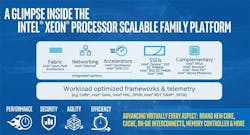It’s a week of transitions for the data center team at Intel. Yesterday the company said that Diane Bryant, who has headed the Data Center Group for the last five years, has taken a leave of absence and will be succeeded by Navin Shenoy, currently general manager of the company’s Client Computing Group.
This morning the chipmaker said it has rebranded its Xeon “Skylake” processors as the Intel Xeon Processor Scalable Family, a move designed to position Intel for an evolving IT landscape in which data center operators are seeking to match hardware to new workloads.
“The Scalable family provides the foundation for the next generation of cloud infrastructure to fuel applications as wide-ranging as analytics, artificial intelligence, autonomous driving, high-performance computing, and network transformation,” said Lisa Spelman, Vice President & General Manager of Intel Xeon products and Data Center Marketing at Intel. “The new Intel Xeon Processor Scalable family represents a major architectural leap forward in processor architecture and platform advancements, delivering workload-optimized performance for compute, network and storage.”
No Technical Details – Yet
Don’t get too excited – all the technical details of the new Xeon processors will remain under wraps until this summer. In the meantime, Intel wants to stay in the middle of a growing conversation about data center hardware. It’s a category Intel has dominated, with north of 90 percent of the server processor market, by some estimates.
But the rise of artificial intelligence and other specialized computing workloads has led some hyperscale data center players to look beyond the CPU and adopt GPUs (graphics processing units), FPGAs (Field Programmable Gating Arrays) and ASICs (Application Specific Integrated Circuits)
The unveiling of the Scalable brand revealed several new integrations.
- The Scalable family will feature integrated performance accelerators, including Intel Advanced Vector Extensions 512 (Intel AVX-512) and Intel QuickAssist Technology.
- Scalable also features Intel Volume Management Device ( VMD), a new platform capability designed to deliver seamless management of PCIe-based (NVMe) solid state drives, including Intel’s recently-launched Optane SSD DC P4800X and Intel SSD DC P4600 drives. Intel VMD enables a “hot plug” capability that minimizes service interruptions during drive swaps.
Intel also will introduce offer four levels of performance and capabilities, grouped in a tiered model based on metals (bronze, silver, gold and platinum) to make the options simple and efficient to choose.
“This new platform also builds on the exhaustive work we’ve been doing with the ecosystem over the past decade to ensure a choice of fully optimized, easy-to-deploy solutions in the marketplace,” said Spelman. “We are working closely with our Builders ecosystem to create a wide range of workload-optimized solutions that will take full advantage of the new capabilities and performance of the Intel Xeon Processor Scalable family.”
Shenoy Succeeds Diane Bryant
The announcement comes a day after a surprise change in leadership at the Data Center Group.
“Diane Bryant has made the difficult decision to take a leave of absence from Intel to tend to a personal family matter,” wrote Intel CEO Brian Krzanich in an email to employees. “She is stepping away for the next six to eight months. Given the extended duration, an interim leader for the Data Center Group (DCG) is not possible. As a result, I have asked Navin Shenoy to take the position of general manager of DCG.”
Since joining Intel in 1995, Shenoy has held leadership roles in the CEO’s office, sales and marketing, and the PC and tablet businesses.
“Management changes can be distracting, but it is critical that we all give Navin, Diane and the CCG leadership team our full support during this transition and focus on delivering leadership products and executing flawlessly,” Krzanich wrote. “And, it goes without saying that my thoughts are with Diane. I look forward to welcoming her back to her next challenging role.”






